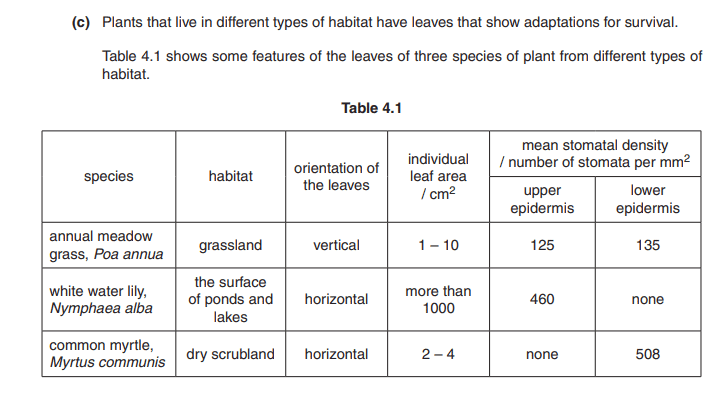Class 10 Exam > Class 10 Notes > Biology for GCSE/IGCSE > Adaptive Features - 1
Adaptive Features - 1 | Biology for GCSE/IGCSE - Class 10 PDF Download
Adaptations & Fitness
- Adaptive features are the inherited functional features of an organism that increase its fitness
- Fitness is the likelihood of an organism surviving and reproducing in its specific environment
- One should be able to analyze images or data of a species to identify its adaptive features, for instance:

A common question may involve explaining how factors like leaf area, stomata distribution, and stomata density contribute to the survival of different plant species in their respective habitats.
Adaptive Features
- Adaptive features are characteristics of an organism that have evolved to improve its survival and reproduction in a particular environment.
- These features can include physical traits, behaviors, or physiological mechanisms.
- Examples of adaptive features are the camouflage of a chameleon, the migration of birds, and the hibernation of bears.
- Organisms with well-developed adaptive features are more likely to thrive and pass on their genes to the next generation.
Types of Adaptive Features
- Structural Adaptations:
- Physical features of an organism that help it survive in its environment.
- For example, the thick fur of polar bears insulates them from the cold Arctic climate.
- Behavioral Adaptations:
- Actions or habits that help an organism survive.
- Migration patterns in birds are a behavioral adaptation that helps them find food and suitable breeding grounds.
- Physiological Adaptations:
- Internal mechanisms that allow an organism to function effectively in its environment.
- For instance, desert plants have adapted to store water efficiently to survive in arid conditions.
Question for Adaptive Features - 1Try yourself: How do physiological adaptations help organisms survive in their environment?View Solution
The document Adaptive Features - 1 | Biology for GCSE/IGCSE - Class 10 is a part of the Class 10 Course Biology for GCSE/IGCSE.
All you need of Class 10 at this link: Class 10
|
101 videos|193 docs|33 tests
|
FAQs on Adaptive Features - 1 - Biology for GCSE/IGCSE - Class 10
| 1. What are adaptive features in biology? |  |
Ans. Adaptive features in biology refer to traits or characteristics that have evolved in organisms over time to help them survive and reproduce in their environment. These features can include physical attributes, behaviors, or physiological functions that increase an organism's fitness.
| 2. How do adaptive features contribute to an organism's fitness? |  |
Ans. Adaptive features help organisms to better adapt to their environment, increasing their chances of survival and reproduction. For example, camouflaged coloration can help prey animals avoid detection by predators, while specialized beak shapes in birds can help them efficiently feed on different types of food.
| 3. Can adaptive features change over time? |  |
Ans. Yes, adaptive features can change over time through the process of natural selection. Organisms with beneficial adaptations are more likely to survive and pass on their genes to the next generation, leading to the spread of those advantageous traits within a population.
| 4. What is the relationship between adaptations and fitness in evolutionary biology? |  |
Ans. Adaptations are traits that increase an organism's fitness, which is a measure of its ability to survive and reproduce in a given environment. Organisms with well-suited adaptations are more likely to have higher fitness levels and pass on their genes to future generations.
| 5. How do scientists study adaptive features in organisms? |  |
Ans. Scientists study adaptive features in organisms through various methods, including field observations, experiments, genetic analyses, and comparative anatomy. By examining how different traits contribute to an organism's survival and reproduction, researchers can better understand the role of adaptations in shaping evolutionary processes.
Related Searches















